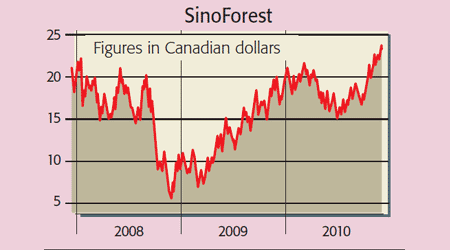Build solid profits from timber
With lumber prices having risen steadily for 200 years, and an average yearly return of 6.5% over the last century, investing in timber is a 'no brainer' says James McKeigue. Here, he looks at one of the most promising stocks in the sector.

Is timber a good investment? Actually, it's a no-brainer says GMO's Jeremy Grantham. "In the sunshine, it grows. If you get stuck with it, it has a negative inventory cost. The rats may come and eat your corn, but trees continue to grow. Five years later, when the economy continues to grow, you've got a bigger tree."
Pine trees are a great illustration of why Grantham loves wood. For the first 15 years of their lives they are good for cheap pulp. But after 20 to 27 years they can be used for telephone poles or plywood and fetch a much higher price. That means that once a tree is planted it grows in value with very little extra work. If the lumber price is low, growers can leave the tree in the ground until the market picks up. And with less and less forest around, prices always recover. Lumber has risen steadily for 200 years, returning an average of 6.5% a year over the last century.
That's not to say growth can be achieved without any effort. The US is still the world's largest lumber market. When America's housing market stalled recently, people stopped building new homes or buying new furniture. Companies making wood and paper products lost money as mills and factories sat idle. Meanwhile, many lumber firms structured as real-estate investment trusts (REITS) saw their net asset values fall as land prices plummeted. Many took cash-flow hits as they were unable, or unwilling, to sell stock as prices fell. And right now the US recovery looks anaemic. So are lumber companies preparing for another lean year in 2011?
MoneyWeek
Subscribe to MoneyWeek today and get your first six magazine issues absolutely FREE

Sign up to Money Morning
Don't miss the latest investment and personal finances news, market analysis, plus money-saving tips with our free twice-daily newsletter
Don't miss the latest investment and personal finances news, market analysis, plus money-saving tips with our free twice-daily newsletter
Actually, no. Massive demand from China has forced up the lumber spot price and given a boost to logging firms. China is the world's second largest consumer of timber and annual demand is growing by around 10%. Government efforts to boost local wood production are not making much headway so China still imports between 30% to 35% of domestic needs.
No amount of intervention from Beijing can disguise the fact that China is seriously short of trees. Forest covers just 18% of its land area half that of many Western countries. Yet China's massive urbanising population needs more and more wood. Today, 600 million Chinese live in cities; by 2030 another 400 million are expected to join them. That's a lot of wood needed for new apartments and furniture. Plus, city dwellers tend to buy goods that come packaged. That creates yet more demand for pulp.
And China doesn't just need wood for its own people. As the world's largest exporter of manufactured goods, including furniture, it also needs timber to keep its industry going. Until recently China mostly used Russian imports to meet any shortfall. However, Russia slapped a big tax on lumber exports in 2008. Timber companies in New Zealand, the US, Canada, and even Peru, have subsequently benefited as China scours the world for wood. Indeed, analysts at Wood Markets estimate that China's lumber imports will double between 2010 and 2015.
High fuel and shipping prices mean that exporting wood from, say, America to China is not an ideal solution. That's why China has tried to make domestic wood production more profitable by, for example, scrapping a forestry levy that accounted for 15% of total costs. Nonetheless, China has little choice but to use foreign expertise, which is why a number of listed timber firms operate there. Their focus is on fast-growing species such as poplar and eucalyptus. Below, we look at the best way to play Chinese timber demand.
The best bet in the sector
Sino-Forest (TSX: TRE) has been developing plantations in China since 1994. The firm has three-quarters of a million hectares of forest spread throughout ten Chinese provinces. That diverse geographical spread reduces the threat from natural disasters. Wood plantations can be damaged by storms or animal attack as the destructive mountain pine beetle in Canada shows.

Recent third-quarter results showed sales were up by 63%, compared to the same time last year. Meanwhile, profits rose by 52% to $221m. Indeed, the company has turned a profit every year since being founded. Around 80% of Sino-Forest's revenue comes from the sale of wood. It generates extra revenue by using its logistical base and local contacts to trade imported Russian wood. A tiny manufacturing arm that makes furniture accounts for the remaining 3% of sales.
After a recent fund-raising effort, Sino-Forest now has a $1.4bn war chest. It aims to use it to plant another half a million hectares. Output is targeted to rise from 14 million cubic metres of wood fibre in 2009 to 17 million by 2011. At $23.25 the company trades below pre-crisis highs. And its earnings potential means that a forward p/e of 9.6 for 2012 looks attractive.
This article was originally published in MoneyWeek magazine issue number 516 on 10 December 2010, and was available exclusively to magazine subscribers. To read all our subscriber-only articles right away, subscribe to MoneyWeek magazine.
Get the latest financial news, insights and expert analysis from our award-winning MoneyWeek team, to help you understand what really matters when it comes to your finances.
James graduated from Keele University with a BA (Hons) in English literature and history, and has a certificate in journalism from the NCTJ.
James has worked as a freelance journalist in various Latin American countries.He also had a spell at ITV, as welll as wring for Television Business International and covering the European equity markets for the Forbes.com London bureau.
James has travelled extensively in emerging markets, reporting for international energy magazines such as Oil and Gas Investor, and institutional publications such as the Commonwealth Business Environment Report.
He is currently the managing editor of LatAm INVESTOR, the UK's only Latin American finance magazine.
-
 High earners face £15k income hit by 2029 following Autumn Budget
High earners face £15k income hit by 2029 following Autumn BudgetRachel Reeves’s Autumn Budget means high earners – or HENRYs – are now looking at an income hit running into the thousands. Can you avoid it?
-
 Millions underestimate how many paydays are left until retirement - why you should be counting your payslips
Millions underestimate how many paydays are left until retirement - why you should be counting your payslipsKeeping track of how long you will be earning a salary for can help work out how much you need to put into a workplace pension
